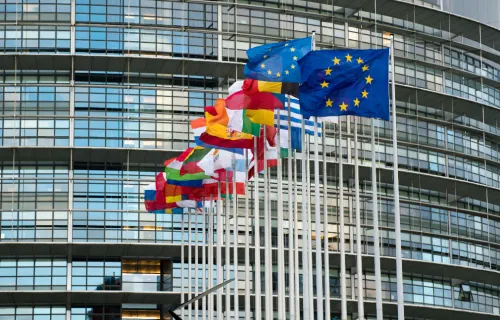In the latest episode of our Energy Transition Talks series, Marion Braams, Vice-President, Consulting Expert at CGI sits down with Peter Warren to share her expert perspective on emerging trends in IT, sustainability regulations and reporting. Specifically, they discuss different ESG initiatives across regions, the evolution to and impact of legally mandated standards and certifications, plus the role of green IT and AI for optimizing data and ESG reporting.
New laws mandating ESG reporting create fairness and accountability
Environmental, social, and governance (ESG) factors are becoming increasingly valuable for businesses beyond just sustainability objectives, as they can impact risk management, stakeholder expectations, innovation and operational efficiency.
Until now, greenhouse gas (GHG) reporting and emissions reductions have been voluntary for companies, meaning companies that invested in being "greener" faced higher costs than those that didn't. However, new laws, like the CSRD in Europe and the ISSB in the US, are making GHG reporting mandatory, creating a more level playing field and fostering more consistency and accountability across industries.
As Marion explains, without standards developed to measure GHG emissions, people were measuring things in their own ways. “You can't just look at something and know how much greenhouse gases (GHG) it contains, like a beer. You cannot just look at your beer and know its cost or energy use. It depends on how it is made, how much time it was stored, for example. It becomes really complicated to calculate things.”
Companies can apply for certifications from organizations like EcoVadis or the Carbon Disclosure Project to verify their GHG emissions. These certifications require companies to use standardized methods to estimate and report their GHG emissions.
‘Green IT’ and ‘Green By IT’ help to “bake in” ESG within organizations
"Green IT" and "Green By IT" are two distinct approaches to using technology in an environmentally responsible manner. "Green IT" focuses on ensuring the IT infrastructure itself is more sustainable, by minimizing the environmental impact (e.g., adopting energy-efficient hardware).
On the other hand, "Green By IT" prioritizes using IT to drive sustainability across the business by, for example, optimizing business processes, reducing resource consumption and enabling more environmentally friendly practices.
Marion highlights three ways organizations use IT to enable sustainability:
-
Data management
IT can help with data gathering, storing, retrieving and reporting. Having a well organized IT portfolio makes it easier to access and understand your data.
- Trend analysis and optimization
IT can be used to run ‘What if’ hypotheses to model the impact of changes to production, transportation, supply chain, etc. Optimizing business processes and using digital twins can also help reduce waste and inefficiency.
- Cybersecurity
Cybersecurity is an important consideration, as a security incident could lead to significant waste and disruption, especially for a manufacturing company.
Regarding ESG, Peter values a holistic business lens that accounts for individual roles across an entire ecosystem and targets specific outcomes. “If you bake in ESG (if you do it properly and bake it in like security, rather than add it on), it drives efficiencies. It drops costs, whether it's simply less processing time on a computer or reducing losses out the back door of a warehousing facility. It gives it a different focus. So, it should be used more as a tool.”
Using AI to get started on your ESG journey
With new laws on the way, Marion suggests using the current year as a trial period, rather than waiting for ESG reporting to become mandatory. Specifically, she recommends looking beyond just structured data in your ERP or CRM systems for CO2 data and using AI to examine unstructured data to find mentions of relevant ESG topics. “So you can easily use AI to find a starting point on what you’ve already published on mobility, material use, office locations, green energy, energy reduction, etc.”
Another use for AI in accelerating your ESG journey is in examining what others in your industry are doing. “You could not only use it for your data, but then you could say, ‘OK, now I have somebody who's in the same industry, and this is their website. What do they say they are doing?’ This can help you understand realistic vs. unrealistic ambitions for your own ESG initiatives and strategically set achievable goals.
“The beautiful thing about the AI we’re applying now,” Peter shares, “is the data probably exists in various formats in the organization already.” It’s about freeing it up to surface insights from the data you already had and making it meaningful for your specific use case.
Marion acknowledges starting an ESG journey can be daunting; at the outset, organizations may find little to no relevant data available. This is a normal part of the process, she explains: “It's like learning a new sport; the first lesson you think ‘I will never learn.’ Don't be disappointed the first day you don't find anything.”
Above all, it doesn’t matter where you start, Marion stresses: “Don't spend too much time looking at where to start, because at the end, you will have to find all the data. And so: just start. Starting is, I think, the important thing.”
Listen to other podcasts in this series to learn more about the energy transition
Read the transcript:
- 1. Introduction to ESG and its importance
-
Peter Warren:
Hello everyone, welcome back to another installment in our continuing story about energy utilities and the changes we're going through. Today we've got a great opportunity to explore environmental social governance, commonly referred to as ESG. Certainly, our industry is going through decarbonization. Carbon tracking has become a huge issue for us and the source of minerals from around the world for electric vehicles (EVs) is a concern.
All of this comes back to hitting us in the wallet at times, in taxation and other components. Marion Brahms is our expert today. Hi Marion, do you want to take a minute and introduce yourself?
Marion Braams (00:43)
Yes, thank you, Pete. I'm Marion Braams. I'm a Vice-President, Consulting Expert at CGI. I've been with CGI now for seven years and my specialty is complex problems. I really like to solve complex problems, especially if they're in the safety or sustainability field. In terms of my background, I have a Master in Informatics.
- 2. Different Standards in Europe and North America
-
Peter Warren
That's cool. Well, we're going to try and make ESG less complicated today. Thank you for your expertise on this. Because you've looked at the complexity of this, it really breaks down into a bunch of areas. Why don't we start with standards? There are different standards in Europe and North America. Maybe you could give your viewpoint on those and how they apply to this.
Marion Braams
Yes. What you could say is that you don't know how much greenhouse gases (GHG) are in something if you just look at it. For example, if you just had a beer, how much did it cost? You don't know. So standards have developed to measure things because people could measure all in their own way and it didn't make any sense, so standards evolved.
You could also say that you had ambitions or targets, but nobody knew if you really were following these ambitions. So you need to have standards, but you also need to have certificates. There are certifying companies like Ecovades or the Carbon Disclosure, for example; there are many. What you can do is you can apply for such a certificate. And then they also ask that you use these standards to estimate or model your greenhouse gases emissions. At the moment, we see that laws are coming. I'm actually very happy with the laws, because it was all voluntary until now. So, companies who had, let's say, a green CIO that could do these things and companies who didn't want to, they didn't have to.
Let’s say that there were some costs involved in being greener. Then the companies who were greener had more costs than the companies who didn't do that because everything was voluntary. Now that laws are coming, it means everybody has to follow the same rules. So it's more a level playing field.
Europe has a law which is called CSRD, which is easy to remember because CSR is also part of ESG. It's corporate social responsibility, but it doesn't stand for that. And the Americans have something which also has four letters, which is ISSB. They look sort of the same, but obviously, everybody has to have their own standards.
Peter Warren
It’s very interesting and what we're seeing in a global economy too is the interconnections between those things. The ISO has also released 147 which is now a way of tracking carbon intensity of any energy source from source to completion effectively, from making it right through to freight-on-board (FOB) the dock of whoever you deliver to (whether it goes through a pipeline, a truck, a boat, however you get it to them).
The fact that it's been made a level playing field even has affected the banking industry. We know that some banks have cut back on some of their ESG funds because they were not getting the data, as you referenced, in a quality or convenient way that they could certify that these investments are there. So, it affects more than just our industry.
- 3. Tools and Materials in ESG Calculations
-
How do tools and materials play into this and how are the calculations done to simplify this as the laws come forward? Is it well understood? Is it relatively straightforward?
Marion Braams
No, it's not relatively straightforward; it’s rather complicated. Let's go back to the beer you had or didn't have. Obviously, you have a long supply chain before you had your cold beer, as there are lots of steps. And in all these steps, there is the energy being used. But not everything is as obvious as it appears. You cannot just look at your beer and know its cost or energy use. It depends on how it is made, how much time it was stored, for example, all those sorts of things. It becomes really complicated to calculate things.
When a number of companies start to disclose their ESG numbers and then make reports, there are others who think, ‘Well, this seems to be a very good marketing tool. Let's also make reports.’ They don't really have results; they just want to report. And if you don't have any data in your report and you have a lot of beautiful stock photos, it could look like OK, but you’re not doing anything of substance. The calculations are really complicated and there are a lot of standards you can use, but you must get into it and see what is truly relevant. And in the European laws, relevance is called material. So, if it is material, which means it's cyclic vacant or it's relevant, then you only calculate that. You cannot calculate everything. That would be impossible, I think.
Peter Warren
Yes, it's breaking it down. I think the initial thinking from of a lot of executives was that ESG would be an accounting job. You know, you put some people together, they read a few things and then they say, ‘Here's my report.’ And I think that's how the first generation of a lot of reports were done. But now it's really getting into the systems, having the data, the auditability of tracking, both internally and externally, on the things that you're making—Scopes 1 and 2, but also into Scope 3.
- 4. Green IT and Optimization of Computer Systems
-
You know, we talk about green IT, about the shift that's happening. People talk about the rainbow of energy colors: green, red, purple, gray and so on, of different types like hydrogen and so on. We’re getting away from that in our industry and moving towards truly tracking the carbon intensity of the energy source and looking at it, but green IT and optimizing the back office as well as the operation systems is still a big thing.
What's your viewpoint on how that plays in, the changes in the computer systems and so on?
Marion Braams
There are two different ways to look at it. You have green IT and you have green by IT. If you want to have green IT, the first thing you have to ask in my business is “Is IT significant? Is it material in the first place? Is my industry IT intensive?” If you have a website with a lot of customers, that's very different than when you have an industry where you have a lot of energy use on production of your materials, but you supply in bulk to only a few customers. In that case, maybe IT is not your biggest worry. And if IT is not your biggest worry, then green IT is not so important for you. On the other hand, green by IT is something else; it means you are using IT to become greener. And I think that is really very important because the new laws that are coming want auditability, which means you have to show that what you did is correct. And as I said, you don't know exactly, so what we do is we do a lot of estimations.
But then maybe two or three years later, you could say, “You know, we did not do our estimations correctly.” So you would like to reassess the data from three years ago, but you still need the data. If you don't keep the data, you cannot reassess. So you can use IT in a number of ways. The first is the data gathering, storing, retrieving and reporting. How your IT portfolio looks helps you to determine if it's easy or difficult to get all this data. If your IT is all over the place, then it is more difficult than when you have your portfolio and you have focused energy on your digital transition in the years up to now. So that is one way IT can help you to really be sure of your data.
Then you can use IT to do trend analysis or “What if” hypotheses. If I change something in my production process, something in my transport, something in my supply chain—would it even matter? You can use IT for that. Then also you could have less waste. If you optimize your business processes and you use a digital twin, for example, then you can know what you're doing, it could be that you find ways to reduce waste. Waste is also wasted energy to produce the waste in the first place.
Cybersecurity sometimes is seen as something else, but, if you have a manufacturing company and you have a cybersecurity incident, you could have a lot of waste in that moment in time. So it could be a very different reason why you also would like to have this done.
Peter Warren
I just wanted to highlight a couple of points you made that I love. One is that it’s about the ecosystem. It’s beyond just looking at what I have; I'm looking at my role in the entire ecosystem and achieving specific outcomes. And it's also the shift away from ESG being something that's being done to me—I remember hearing one executive talk about how “This is going to bankrupt us”—to the fact that if you bake in ESG (if you do it properly and bake it in like security, rather than add it on), it drives efficiencies. It drops costs, whether it's simply less processing time on a computer or reducing losses out the back door of a warehousing facility. It drives it out. It gives it a different focus. So, it should be used more as a tool.
- 5. The Role of AI in ESG Reporting
-
AI is, of course, one of those interesting tools everybody's talking about. It always starts with the use case, and then determining if you have the data to get it done. How do you see that playing in here? That'd be a great thing to touch base on.
Marion Braams
The first thing you could look at is, let's say that you must start a journey on ESG reporting because these laws are coming and you think, “I'm not going to wait for it to be mandatory. I'm going to use this year as a sort of trial year.” So, you look in your ERP or CRM or whatever and no CO2 data can be found anywhere. What you could do is not only look at your structured data, but also unstructured data. For example, if you publish all your interviews, all your podcasts, everything on your website and ask AI, “Do we mention anything about mobility of our employees anywhere on our website?” So you can easily use AI to find a starting point on what you’ve already published on mobility, on material use, on where your offices are, on green energy, on energy reduction, on whatever you did.
Another approach would be to look at what others do. You could not only use it for your data, but then you could say, “OK, now I have somebody who's in the same industry, and this is their website. What do they say they are doing?” That could really help you to see what realistic and unrealistic ambitions would be. Those are just two examples of how AI could help you to start on your ESG journey.
Peter Warren
That’s brilliant. The beautiful thing about AI that we're applying now, is the data probably exists in various formats in the organization already. So how do I free it up and making it meaningful to the specific application I want in the use case? And we're doing that across the board. Time's ticking on this, so we'll wrap up in a second.
Getting Started with ESG Reporting
Any final thoughts or areas you'd like people to think about and I'll give you the final word here.
Marion Braams
Yes, thank you. One, when you start on your ESG journey, it can be daunting to find the data because when you start, you often find nothing. So it’s not your fault. That's just what you should expect if you start a completely new journey. It's like learning a new sport; the first lesson you think “I will never learn.” Don't be disappointed the first day you don't find anything.That's just how it goes.
Also, it doesn't matter where you start. In ESG, if ‘S data’ (social data), is easier to find, start there. If there is something your CEO already finds very interesting, start there, because the journey will be the same. Don't spend too much time looking at where to start, because at the end, you will have to find all the data. And so: just start. Starting is, I think, the important thing—and expect setbacks. That's how it's going.
Peter Warren
I think that's brilliant. I heard the phrase years ago: it's paralysis through analysis. People stop moving because they get so caught up in what to do and where to get it. I think your recommendation of just get started with what you've got and then find the gaps as you go is probably the best agile approach to getting the outcomes they want.
Thank you very much, Marion. I appreciate you hugely. Great working with you and everyone on the call. Thank you for your time and we'll see you in the next one. Bye -bye.









